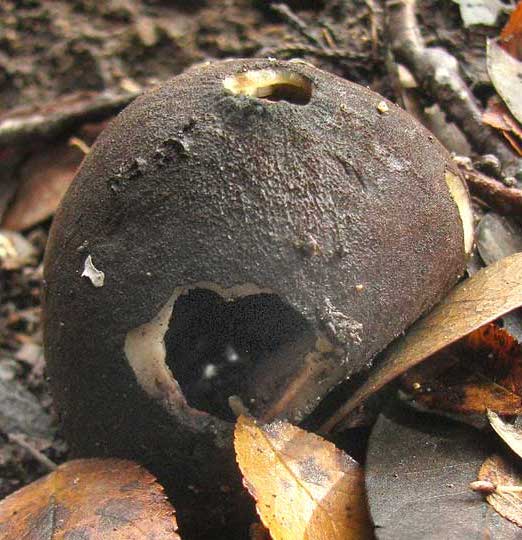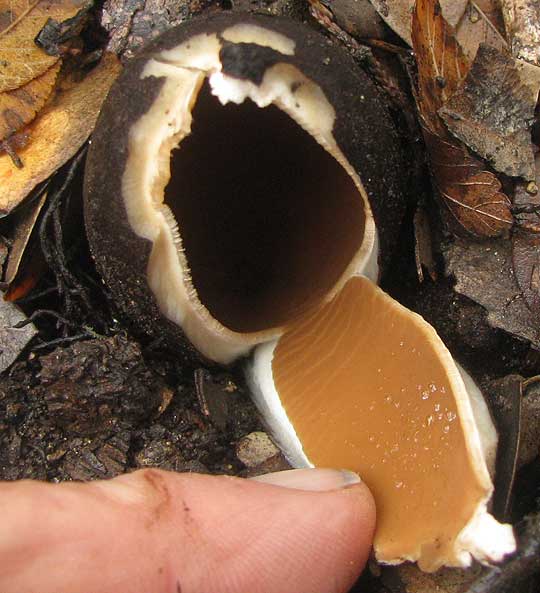Excerpts from Jim Conrad's
Naturalist Newsletter

from the December 1, 2013 Newsletter issued from the Frio Canyon Nature Education Center in the valley of the Dry Frio River in northern Uvalde County, southwestern Texas, on the southern border of the Edwards Plateau; elevation ~1750m (~5750 ft); N29.62°, W99.86°; USA
TEXAS STAR MUSHROOM
In rich, heavily shaded soil at the foot of our hill, just below a low ledge of outcropping limestone, I found the dark nuts of two acorns curiously situated very close together and with their pointy tops directed skyward. You can see their puzzling appearance above.
But, this just wasn't right. Acorns don't position themselves in such a manner. Looking around for other examples, I found three or four others scattered about just below the limestone outcrop, but they occurred singly. Most of the others had holes in them, apparently where rodents or birds had nibbled. One is shown below:

But, acorns don't display white flesh beneath blackish skin. This was a fungus, but a fungus unlike any I'd seen. It was hollow. With a finger I pried away one side of one, the side seeming to break cleanly along fracture lines not apparent from the outside. You can see this below:

The fungus's colored inner face suggested that this was an earthstar fungus, or something closely related, though this was unlike any earthstar I'd seen, even in photos. When earthstars mature, their several slender, sharp-tipped "arms" curve outward until they lie against the ground, causing the fungus to assume the shape of a star. In the picture, I've peeled away an arm.
After browsing hundreds of pictures of earthstars on the Internet, nothing turned up like our find. Finally, like a rank amateur, I Googled the keywords "fungus star-shaped Texas," and up came what looked like our discovery might become at maturity. It was the Texas Star, CHORIOACTIS GEASTER.
But, Texas Stars are not earthstars. The many earthstar species belong to the fungal phylum Basidiomycota. Texas Stars belong to the Ascomycota. Taxonomically, phyla are the next main subdivision after the kingdom, so saying that something belongs to a different phylum is like saying that an animal is a vertebrate instead of a sponge or starfish. Texas Stars may resemble normal earthstars, but they are profoundly unrelated fungal types.
Chorioactis geaster is such a rare and unusual species that I feared announcing that I'd found some without having the identification confirmed. I sent the pictures to Tim Wheeler at http://www.fungaljungal.org, who agreed that that's what it looked like, but to be sure he shared the pictures with Texan David Lewis, president of the Gulf States Mycological Society, mycology being the study of fungi. David Lewis's verdict:
"Yes, it is Chorioactis geaster. It seems to range from around the Austin area up to Dallas. Its range extends along the Balcones Escarpment, a limestone area in Texas."
This is one of my best Texas finds yet. We are at the western end of the Balcones Escarpment, which physiographically corresponds with where the Edwards Plateau meets the Gulf Coastal Plain.
One of the most remarkable things about Chorioactis geaster is that in the entire world it is known only from a handful of counties in the area described by David Lewis, and a couple of very limited spots in Japan! Sometimes fungi, whose spores can travel on winds for hundreds and apparently thousands of miles, do exhibit such "disjunct" distributions. Recent genetic analysis indicates that the Japanese and Texas populations have been separated for at least the last nineteen millions years.
Chorioactis geaster is such an unusual species that it's the only species in its genus, Chorioactis. The preferred host of Texan populations is typically roots and stumps of Cedar Elms, Ulmus crassifola, and there was a big Cedar Elm near where I found our fungus.
You can see a picture of the mature Texas Star with its arms open, and read a good bit about the discovery, debates and eventual figuring out what it was at https://en.wikipedia.org/wiki/Chorioactis.
from the January 5, 2014 Newsletter issued from the Frio Canyon Nature Education Center in the valley of the Dry Frio River in northern Uvalde County, southwestern Texas, on the southern border of the Edwards Plateau; elevation ~1750m (~5750 ft); N29.62°, W99.86°; USA
A HALF-OPEN TEXAS STAR
Last month's unopened Texas Stars never did develop into the widely spreading
"stars" that make them so spectacular at certain times of the year. Ours partially opened but then dried up and turned into a contorted, black mess. Now another one that wasn't apparent earlier, apparently because it formed deeper in the soil, is partially open, as shown below:

I'm watching it, hoping it'll develop, but it's set so deeply in the soil I wonder if it can ever fully expand.